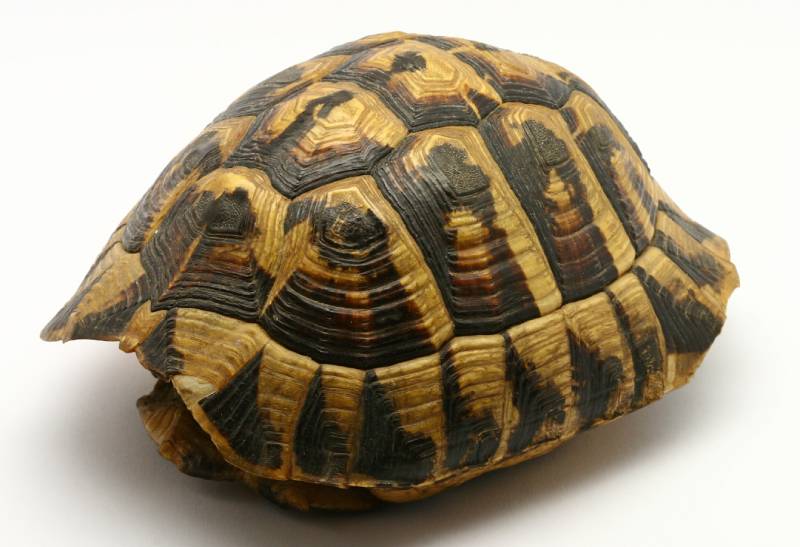How to Tell if a Turtle Is Dead: 8 Vet-Reviewed Signs to Look For
Updated on

Turtles are amazing creatures that are loved around the world. They are unique in that they are encompassed by a shell that acts as armor for protection, and despite some misconceptions, they cannot leave their shell.
Sadly, all animals perish at some point, but with a turtle, it may be hard to determine if they’re alive or dead, especially due to brumation, which is similar to hibernation where a turtle goes through a winter rest period to survive winters with scarce rations. The turtle may burrow into soft soil and remain inactive, giving the impression that they’re dead.
So, how do you tell if a turtle is dead? In this post, we’ll list eight signs to look for to verify if a turtle is truly deceased.
The 8 Signs a Turtle Is Dead
1. No Stimulation Response
As mentioned above, turtles undergo a brumation process in cold months to slow down their systems and conserve energy. During this process, they go dormant with little to no movement. However, even a brumating turtle will show some type of response when touched or stimulated, especially if you touch their cloaca, an opening at the back that acts as a waste eliminator, as well as being used for sexual reproduction and egg laying.
You can also try gently touching their legs—if there is no response, the turtle is unfortunately dead.

2. Foul Smell
When a turtle dies, its body typically starts decomposing immediately. Bacteria and microorganisms will begin digesting the carcass, which leaves behind a foul odor. The body will produce gasses as well, which also gives off a rather unpleasant odor.
3. Cold to the Touch
Another sign a turtle is dead is its body will be cold to the touch. However, this is not a full-proof telltale sign because a turtle’s body temperature will drop during brumation. But if the body is extremely cold, the turtle has likely passed.
4. Sunken, Deep-Hollowed Eyes
Sunken eyes can be a sign of dehydration, but it can also be a sign that the turtle has passed on. Once decomposition begins, the eyes will appear sunken. However, try to stimulate the turtle if you notice sunken eyes to positively determine if the turtle is deceased.

5. Shriveled and Sunken Skin
If a turtle is dead and the decomposition process has begun, the skin will become shriveled, have a shrunken appearance, and be loose. The skin does not take on this appearance during brumation, and if you see the skin in this way, the turtle is likely deceased.
6. Maggots and Flies
Seeing maggots or flies on your turtle can be an unsettling site, but it may not definitively determine that the turtle is dead. Injuries to turtles can result in “flystrike” maggots, and if left on the turtle, these maggots may ultimately kill them. However, if a turtle is infested with flies and maggots and not moving, the turtle is likely deceased.

7. Rotten or Shriveled Shell
As decomposition takes over, the shell and skin will rot as part of the process. However, while a turtle’s shell may become soft during brumation, you should be able to tell if the shell is indeed rotting, especially when it’s accompanied by a foul odor, which will likely be present.
8. Limp Legs
Lastly, a sign of a deceased turtle is if the legs are limp. A brumating turtle is very still; however, the muscles in the legs are still under control during the brumation process. A deceased turtle’s legs will protrude from the shell and swing aimlessly in a limp manner.
How to Tell if Your Turtle Is Breathing

In addition to the methods mentioned above to determine any signs of life, you can also simply check to see if your turtle is breathing. Keep in mind that a turtle’s breathing slows way down during brumation, but you can still check, nonetheless.
Try holding a feather or something similar in front of the nostrils that will show movement when the turtle blows air out of the nostrils. However, be patient, as it could take at least 10 minutes to see any movement of the object in front of the nostrils if the turtle is brumating.
You can also check their behind (the cloaca region) to see if it pulsates or moves upon stimulation. Again, be patient and give it at least 10 minutes before determining if there is life or not.
Consult Your Veterinarian
When all else fails, take your turtle to a veterinarian to make a conclusive determination. If your turtle is sick, your veterinarian can administer treatment.
Conclusion
No one likes to think of the death of their pet, but unfortunately, all animals die eventually. Whether you spot a turtle on the side of the road or you have a pet turtle, it’s important to know how to determine if they’re alive or dead by implementing the steps mentioned above. Remember that just because a turtle is still does not mean they are dead, as they could be brumating.
See Also:
Featured Image Credit: Bigc Studio, Shutterstock












